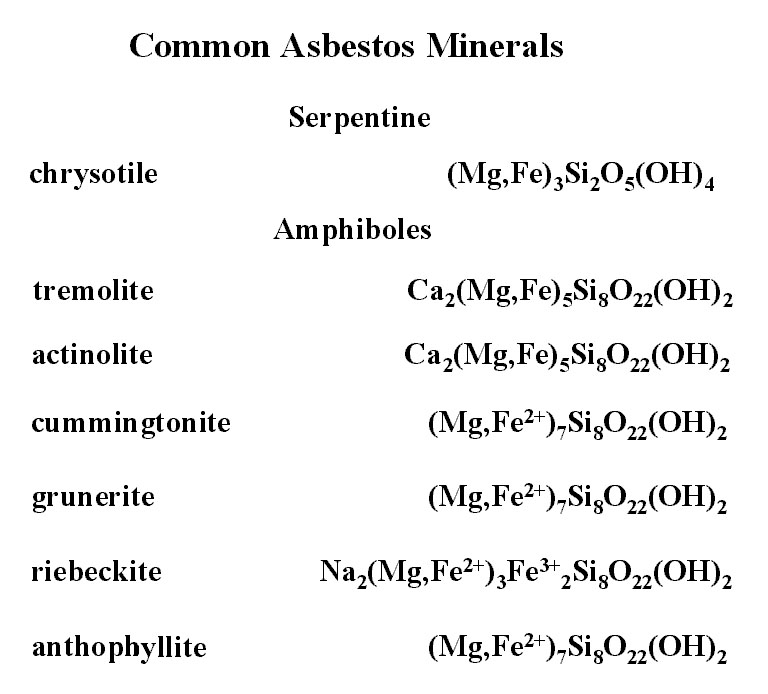 |
|
|
||||
| OFR 01-0429: World Trade Center Asbestos Primer |
| About USGS / Science Topics / Maps, Products & Publications / Education / FAQ |
Asbestos is a commercial term that represents several different silicate minerals which separate into long thin fibers, are heat resistant, and are chemically inert. Over the years, asbestos has been used in numerous commercial applications including fire proofing materials, ceiling tiles, floor tiles, insulation, brake linings, and many more. Since the nineteen seventies, the use of asbestos in commercial products has greatly diminished due to health concerns and demonstrated links to diseases such as asbestosis, mesothelioma and lung cancer. Asbestos can be divided into two major classes of minerals, serpentines and amphiboles.
Chrysotile (includes the minerals clinochrysotile and orthochrysotile) is the only asbestos mineral of the serpentine group and has been the most widely used commercially. Chrysotile is a sheet silicate comprised of bundles of extremely small, tightly rolled sheets that form tubes or rods. Chrysotile has been more widely used than amphibole asbestos because it is usually more flexible, forms longer thinner fibers, and can easily be woven into cloth. Chrysotile is not as chemically inert as the asbestiform amphibole minerals.
All other asbestos belongs to the amphibole family of minerals. Amphiboles are chain silicates that include over fifty different minerals, most of which do not crystallize in asbestiform varieties. Of the few amphiboles recognized to crystallize in asbestiform varieties, those that have been used commercially are grouped into five materials that are referred to both in commercial and regulatory nomenclature as; amosite (includes the asbestiform varieties of the amphibole minerals cummingtonite and grunerite), crocidolite (asbestiform variety of the mineral riebeckite), tremolite (asbestiform variety of the mineral tremolite), actinolite (asbestiform variety of the mineral actinolite), and asbestiform anthophyllite. Other amphiboles can occur in asbestiform varieties, but these minerals have generally not been used in commercial products and are often not cited in the regulatory literature.
Listed below are the nominal (pure) chemical formulas for the most common asbestos minerals. It is rare, however, to find pure compounds in natural materials. Considerable chemical substitution often occurs in in these minerals, particularly the amphiboles. As examples, some amount of sodium (Na) and potassium (K) often substitutes for calcium (Ca), and aluminum (Al) and titanium (Ti) can substitute for silicon (Si).

A significant body of research conducted over the last twenty years by toxicologists, epidemiologists and mineralogists suggests that the amphibole asbestos minerals are more toxic than chrysotile (Ross, 1999; Skinner et al., 1988; Van Oss et al., 1999; McDonald, 2001). This conclusion, however, has not been universally accepted by the scientific community. A recent and thorough discussion of this ongoing debate can be found in Nolan, et al. (2001).
Definitions:
Asbestiform: The physical form or appearance of minerals that consists of long, thin and sometimes flexible fibers or needle-like structures.
Chain Silicate: A class of silicate minerals that form in structural chains. In some of these minerals the chains can separate easily along parallel crystallographic planes and can form fibrous or needle-like structures. Amphiboles and pyroxenes are members of the chain silicate family.
Mineral: A naturally occurring material with a specific chemical composition or range of compositions, and a specific crystalline structure.
Sheet Silicate: A class of silicate minerals that form in structural sheets and often break easily along one crystallographic plane so as to form extremely thin flat plates. Members of this mineral group include micas, clays, and serpentines.
* The above definitions are descriptive and are not intended to be used in the technical evaluation of materials containing asbestos.
Back to document Table of Contents
| AccessibilityFOIAPrivacyPolicies and Notices | |
| |
|